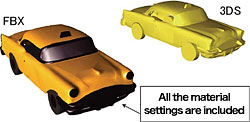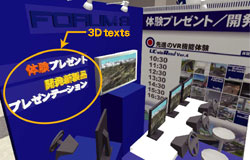
UC-win/Road Version 5 development has been completed: the main new features are as follows:
- 3D display features: FBX models, LOD, text display function, advanced weather visualization
- Accuracy of driving simulation: Improved vehicle dynamics model, improved audio, linkage with Senso Drive
- View angle controls: Navigation features
- Data linkage: FBX file compatible, Point Cloud Data Plug-in option
- UC-win/Road for SaaS: SaaS server function (sold separately)
- Data creation: rivers, 3D text models
1. FBX file compatibility
- FBX is a file format developed by Autodesk. To enable easy 3D data exchange between 3D applications, Software Development Kit (SDK) for FBX, samples and FBX viewer are provided by Autodesk free of charge.
FBX data import function was developed to extend the file formats supported by UC-win/Road. During the data import, material attributes, textures and the polygon information, which are included in the FBX data, are imported and can be used in UC-win/Road as 3D models.
Previous versions of UC-win/Road have been able to import 3ds files, but this file format is not officially documented, thus, full compatibility with 3ds is not possible. From this version, FORUM8 plans to update features regarding 3D models with focus on the FBX, with the view to develop functions for exporting to FBX files, and compatibility with animation, light source and view angle data within FBX files.
2. LOD function
- LOD function is used to adjust the resolution of the display according to the size of the display, when elements are depicted in a 3D environment. By lowering the resolution of smaller elements, the processing time can be reduced without badly affecting the quality of the visualization. This technology enables us to increase the number of elements that can be visualized simultaneously, and in some cases, improves the system performance.
In UC-win/Road version 5, as shown below, we have developed and improved the LOD function.
- MD3 character
Now, MD3 characters are displayed in three phases of LOD. Maximum LOD utilizes the same methods as before. In the second phase of LOD, the character is displayed on rectangular panes. The textures of the front and the side views are generated internally from the 3D mesh data which will become the basis of the character.
In the third phase, the character is displayed as a bar or a dot. In addition, users can alter the view angle to switch between various the LODs.
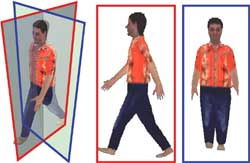
Original mesh / Side texture / front texture  MD3 character generated by the LOD second phase
MD3 character generated by the LOD second phase
- Shadow
Elements to be used for shadows can now be selected to optimize the display speed of shadows.
The texture size for shadow generation can also be altered, enabling the adjustment of the resolution of the shadows.
- Lake and Pond
To visualize the reflections on the lakes, images in the 3D environment has to be generated twice. However, since the quality of the images on the lake surfaces is unimportant in most cases, the resolution of the reflection on the lake surfaces can now be lowered.
- 3D trees
Three more phases of LOD are now available and UC-win/Road version 5 now has four phases of LOD in total for 3D trees- First Phase: Maximum LOD display
- Second Phase: Static 3D trees - unaffected by the wind
- Fourth Phase: 3D tree displayed on 4 intersecting panes
- Fifth Phase: 3D tree displayed on 2 intersecting panes
3. Creating rivers
- River creation is now improved in UC-win/Road version 5 - just like with
roads, planar and longitudinal linear alignment is now possible.
In addition, the cross-section of rivers can now be edited, enabling the creation of natural and artificial rivers.
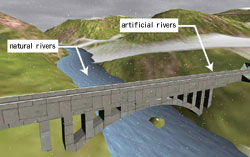
 Sample river model
Sample river model
4. Improvement in road section editor
- Road section editor has been improved as follows:
- Road sections can be created in independent blocks
- Water surface definition can be edited
- Roads can be created without carriageways (thus, disabling vehicles from following lanes on road)
5. Vehicle dynamics
- Vehicle dynamics during driving simulation have been improved. In the previous version, engine braking and creeping forward of automatic vehicles were integrated, but in this version, vehicle suspension and tire models can also be altered for more immersive and precise driving experience, especially when used with motion platform.
- Suspension
In previous versions, the tilt of the vehicle reflected the inclination of the road. In version 5, the addition of suspension to the vehicle dynamics enabled the dynamic simulation of the pitch and roll movements. Each wheel responds to the texture of the road, thus, movement along rough roads is simulated realistically. Also, the tilting of the vehicle in response to the yaw, forward and backward acceleration can be simulated also.
- Tire models
The acceleration and angular acceleration is calculated from the force that is applied to each wheel. With consideration to the friction coefficient between the road surface and the tire, the effects of slippage, under-steering and over-steering can be simulated.
Users can edit the suspension parameters and the tire model in vehicle behavior profile. You can now set friction coefficient for individual lanes as a way to reproduce various driving conditions.
6. UC-win/Road for SaaS Plug-in >> UC-win/Road for SaaS
- This plug-in option enables the setting up of SaaS service server. Clients can remotely control VR space, change viewpoint, travel on roads and flight paths, change environment settings and run scripts. Since multiple users can access the same model simultaneously, UC-win/Road models can be made open for public access, or used in a meeting over a private server.
Moreover, this plug-in has a video transmission function, enabling linkage with other multimedia applications and projection on to virtual web camera.
7. Navigation function
- The navigation feature was revised extensively to improve the movement
of camera inside the UC-win/Road VR environment. Movement modes were devised
to clearly demarcate actual movement and change in viewpoint, which is
now changed inside various movement modes. Some viewpoint operations are
not available in some of the movement modes, but the operation methods
are all the same when changing viewpoints. There are five movements modes,
as listed below:
Movement mode Available viewpoint operations Free movement Roll, forwards and backwards, right -left, up-down, fly through, aerial view, jump Travel on road,
flight path and driving simulationRoll, circle around an object, aerial view Pedestrian Roll, jump Pursuit Circle around an object, aerial view
- Movement modes
- Free movement: the camera can be moved around the 3D environment freely
- Travel on road, Flight: travel along roads or flight paths
- Driving simulation: drive along roads using a game control or a driving simulator
- Pedestrian: walk around the 3D environment using the keyboard
- Pursuit: the camera follows the selected 3D model - for example follow a vehicle inside traffic simulation
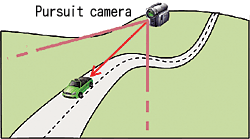
 Pursuit movement mode
Pursuit movement mode
- Viewpoint operation
All operations are carried out on a mouse.- Forwards and backwards and left-right, up-down movements, and fly-throughs are all based on the existing features.
- Roll: camera directions are controlled by this operation. In pedestrian mode, movement direction will change with the camera direction. In travel on road, flight path and driving simulation modes, camera directions can be changed while moving.
- Circle around an object: Camera revolves around a selected object, the vehicle that is being driven, and the travel and flight positions. Objects can be viewed from any angle, and dynamic models, as well as static models can be observed, making it possible to be used during pursuit mode also.
- Aerial view: on top of the features that are already available, aerial view can also be used to track objects.
- Jump: double click on the mouse to move the camera to any location automatically.
8. Improved audio
- New driver
In the previous versions, Direct Sound API was used. This is a Microsoft API from the DirectX Library Collection. However, due to the change in the configuration in the OSs after Windows Vista, all calculation was being done by the CPU without the sound card. In version 5, to accelerate the hardware processing speed, an API called OpenAI is utilized.
- Driving simulation vehicle
The engine sound of the vehicle during driving simulation has been improved. Multiple sound sources can now be configured to simulate various engine sounds according to the RPM. Moreover, volume profiles can be adjusted according to the RPM also.
- Synthesizing engine sound and sound source
Sound of the wind and the tires can now be reproduced. The sound of the wind can be varied by vehicle types and the sound of the tire is variable according to the road surface materials. The frequency and the volume changes according to the driving speed, and detailed settings for the sound volume is also possible.
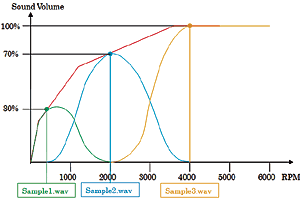
 Synthesizing engine sound and sound source
Synthesizing engine sound and sound source
- Background sounds
Other vehicles: sounds from up to 10 vehicles in the proximity of the camera can now be reproduced. 3D audio effect is achieved using EAX (Environmental Audio eXtensions) library which includes doppler effect.
Low-pass filter: low-pass filter is used to simulate the inability to hear the higher frequencies from inside a vehicle. Low-pass filter settings can also be altered.
- Reverberation
Reverberation inside tunnels is also simulated.
9. 2D/3D texts
- Text display is improved in UC-win/Road version 5
Texts displayed during scenarios and scripts are now visualized using OpenGL.
Moreover, using the 3D model generation function on OpenGL, 3D texts can now be placed inside the 3D environment easily.
10. Miscellaneous
- UC-win/Road version 5 SDK is compatible with Delphi 2010
- Point Cloud Data Plug-in Option enables editing and visualization of point clouds, and road modeling based on point clouds.
- Advanced weather visualization: Improved volume fog and other weather expressions:
lightning, rain ripples, splashing of the rain, reflections on wet roads, wind and tsunamis are added to the expression of the weather and the environment. - UC-win/Road now links with SENSO-Wheel following the linkage with CarSim. Feedback on the steering wheel can now be simulated more accurately.
UC-win/Road Ver.5.0 planned release date: August2010
